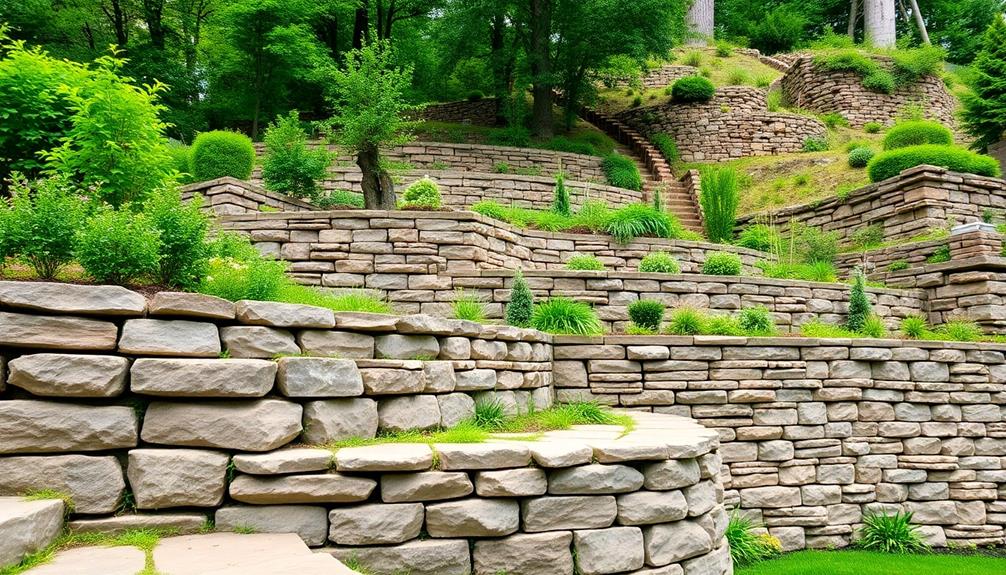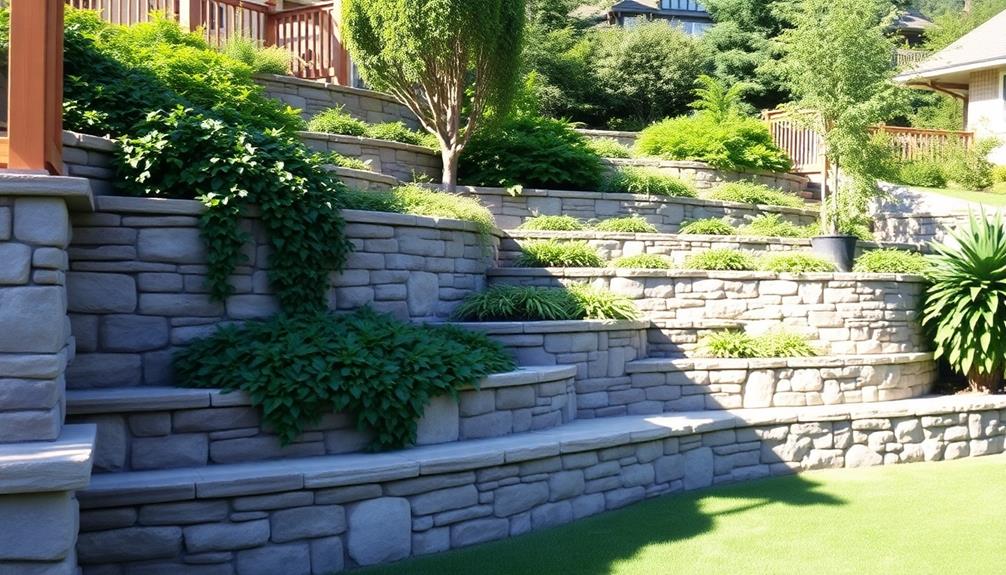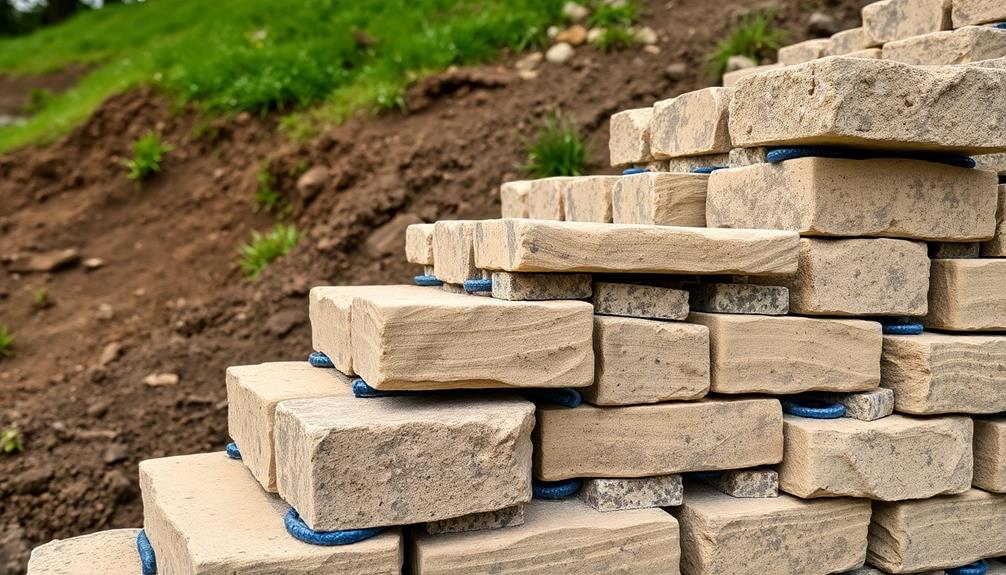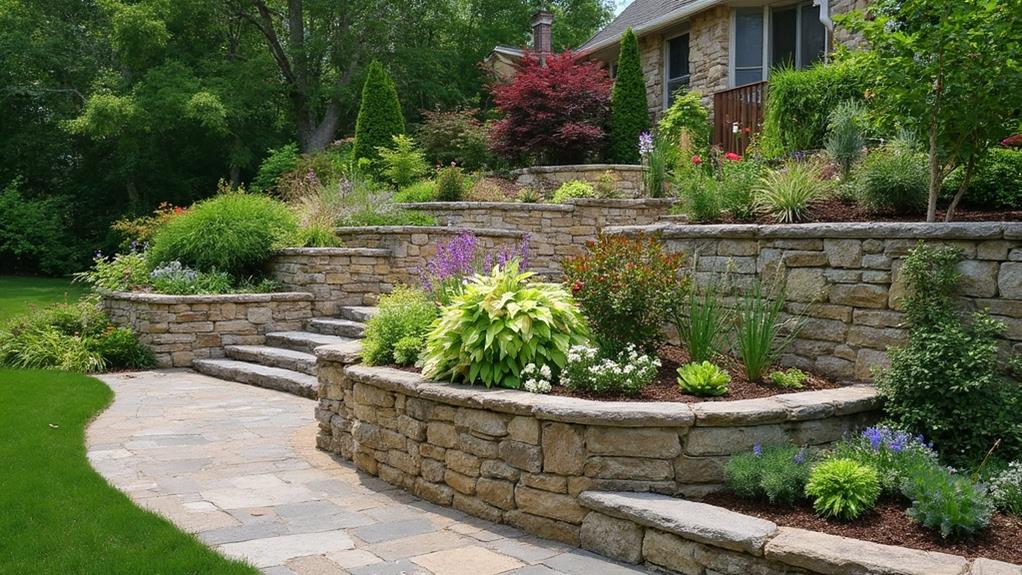The best retaining wall construction methods include a strategic combination of structural support, soil erosion prevention, and aesthetic enhancement. Ensuring stability involves advanced engineering techniques and durable materials such as concrete and steel reinforcements like geogrids and tie-backs, tailored to specific environmental conditions. The integration of proper drainage systems mitigates water-induced erosion, preserving landscape integrity. Aesthetic considerations allow for design customization, incorporating a variety of textures, colors, and shapes to harmonize with existing environments and boost property value. These elements collectively create a resilient and visually cohesive structure, enhancing both functionality and appearance across diverse landscapes. Explore further to uncover detailed methodologies.
Table of Contents
ToggleWalls Contractor Highlights
- Geogrid and tie-back reinforcements improve structural resilience and support in retaining wall construction.
- Concrete walls offer long-term stability and adaptability with various reinforcement techniques for durability.
- Tiered retaining walls enhance pressure distribution and integrate aesthetically with natural terrain for stability and appeal.
- Proper drainage systems are crucial for preventing soil erosion and maintaining the integrity of retaining walls.
- Customization of retaining walls includes diverse materials and design options to match property aesthetics and architectural styles.
Foundational Importance of Retaining Walls

Retaining walls serve a critical role in providing essential structural support, particularly on sloped landscapes where they counteract the lateral pressure of soil and prevent destabilization. Companies like Granite Company specialize in creating such retaining walls for over 20 years, ensuring they meet building code requirements and are constructed with structural integrity.
Beyond their structural function, these walls are pivotal in mitigating soil erosion, consequently preserving the integrity of the terrain and protecting adjacent structures. Additionally, retaining walls offer opportunities for aesthetic enhancement, transforming functional barriers into integral components of landscape design that harmonize with their surroundings.
Essential Structural Support
Frequently underestimated yet integral to landscape architecture, the foundational importance of retaining walls lies in their ability to avert soil erosion and manage water runoff while defining boundaries in both residential and commercial spaces. These structures are more than mere enhancements; they are pivotal to maintaining the structural integrity of landscapes.
At their core, retaining walls act as essential support systems, counterbalancing lateral pressure, and thus shielding your property from displacement of soil and the subsequent cascading failures that arise from it.
Constructed from a variety of materials such as concrete, stone, or wood, these walls must be meticulously designed to endure the immense pressures exhorted by the earth behind them. The secret to their structural efficacy lies in their engineering—strategically angled backs, robust foundations, and reinforced materials designed to withstand both natural forces and time itself. Each element plays a fundamental role in creating a cohesive barrier that steadfastly restrains the earth.
The dedication to precise design and construction speaks to our shared desire for a harmonious and stable environment. Retaining walls, when expertly built, provide the community with not only an aesthetic appeal but also a sense of security, fostering a collective appreciation for well-kept spaces.
Preventing Soil Erosion
Understanding the foundational importance of retaining walls, it naturally follows to explore their role in preventing soil erosion. Retaining walls serve as essential barriers that stabilize soil in areas where gravitational forces might otherwise cause it to shift. By effectively holding soil in place, these structures minimize the movement of particles that occur during erosion processes, which can otherwise lead to significant landscape transformation and property damage. This function is especially critical in areas with steep slopes, where natural forces exert increased pressure on soil structures, threatening stability.
The intricate design of retaining walls incorporates drainage features that further combat erosion. Proper drainage guarantees that water, a primary catalyst of erosion, is directed away from vulnerable areas, thus diminishing the risk of soil displacement. Additionally, advanced construction techniques, such as tiered retaining wall systems, enhance the wall's ability to distribute pressure evenly while seamlessly integrating with the natural terrain.
For communities seeking to preserve their environment and property value, retaining walls provide an assurance against erosion-related damages. This not only fosters a sense of belonging within the landscape but also encourages sustainable land management practices. Emphasizing their preventive role against erosion solidifies retaining walls as pivotal elements in environmental conservation.
Enhancing Landscaping Aesthetics
A well-designed retaining wall can significantly enhance the aesthetic appeal of a landscape by adding structure and dimension. Retaining walls provide an opportunity to create visually appealing environments through the strategic use of materials, textures, and colors that harmonize with the surrounding natural elements. These walls can transform otherwise underutilized spaces into functional and attractive areas, offering a sense of cohesion and continuity throughout the landscape.
In addition to their structural functions, retaining walls can serve as focal points or backdrops for gardens, terraces, and other outdoor living spaces. They allow for the incorporation of curves and unique geometrical designs, fostering a personalized touch while increasing the overall curb appeal. For communities that place high value on aesthetic coherence, retaining walls can blend seamlessly with existing architectural styles, fostering a sense of unity and belonging.
Moreover, lighting elements can be integrated into retaining walls to illuminate pathways and highlight features, providing both practical and aesthetic benefits after sunset. This thoughtful integration not only enhances safety but also accentuates key aspects of the landscape, inviting community and family interactions. The right retaining wall can consequently transform a simple space into a picturesque and engaging environment.
Benefits

Retaining walls offer numerous advantages, chief among them being enhanced structural stability, which provides essential support to prevent land slippage and maintain the integrity of landscapes. They are also excellent for stairways, providing customizable dimensions and location to suit various outdoor spaces.
Beyond their functional role, these constructions also contribute aesthetic value, presenting diverse design options that can complement and elevate the visual appeal of a property. Additionally, by effectively controlling soil erosion, retaining walls not only preserve environmental quality but also contribute to increased property value over time, offering a practical and financially beneficial solution to property owners.
Enhanced Structural Stability
The core advantage of employing robust retaining wall construction methods lies in the enhanced structural stability they provide. Well-constructed retaining walls are indispensable in maintaining the integrity of landscapes, preventing soil erosion, and managing the gradient of land, especially in areas where natural slopes need reinforcement. Utilizing advanced engineering techniques and high-quality materials, these methods ensure that walls can withstand the pressures exerted by the earth and water over time. Proper drainage systems, meticulous design, and precise calculations significantly contribute to their resilience.
For those within the community who value enduring solutions, the reliability of a solidly built retaining wall offers peace of mind. It stands as a symbol of resilience, symbolizing a collective commitment to maintaining and enhancing shared spaces. When these structures are ideally designed, they not only serve their functional purpose but do so with a steadfast assurance, anchoring the surrounding environment against unpredictable natural forces.
Moreover, enhanced structural stability supports long-term cost efficiency. By reducing the need for frequent repairs and adjustments, investment in superior construction methods is a prudent choice, fostering a sense of belonging to a forward-thinking community that prioritizes safety and sustainability. The practical benefits extend beyond mere function, encompassing broader impacts on communal well-being.
Aesthetic Design Options
How do aesthetic design options enhance the appeal of retaining walls? They offer the opportunity to not only serve a functional purpose but also to integrate and complement the surrounding landscape seamlessly. By utilizing a diverse palette of textures, colors, and materials, retaining walls can be customized to reflect the unique character of a property while adhering to stylistic preferences, which fosters a sense of cohesion and belonging within the community.
One significant advantage is the versatility in material selection, ranging from natural stone and brick to more contemporary options like decorative concrete or timber. This wide array of choices allows retaining walls to align with various architectural styles, ensuring they either stand out as a focal feature or blend harmoniously with existing structures. Additionally, incorporating elements such as seating, planters, or illumination further enhances the functionality and aesthetic appeal of these structures.
Design flexibility also extends to the formation and curvature of the wall itself, allowing for creative configurations that enhance visual interest while maximizing usability. Through thoughtful design, retaining walls can become an integral, inviting component of landscapes—encouraging social interaction and creating a sense of place where individuals feel connected to their environment.
Soil Erosion Control
Curtailing soil erosion effectively is a primary benefit of constructing retaining walls, as they play an essential role in stabilizing slopes and managing runoff. Retaining walls serve as a robust barrier against the natural forces of weathering and water movement, providing indispensable support to soil structures.
These strategically placed barriers prevent the natural migration of soil, which is especially beneficial in areas subject to heavy rainfall or rapid snowmelt. By controlling water flow and minimizing soil displacement, retaining walls mitigate risks that lead to structural instability and land degradation.
Moreover, retaining walls help maintain the integrity of landscapes by upholding soil quality and preventing the loss of nutrient-rich topsoil. This ability to conserve topsoil not only bolsters the ecological health of the area but also supports sustainable landscaping practices, providing homeowners and communities with viable solutions to protect their natural resources.
The collaborative effort invested in selecting appropriate materials and construction techniques for retaining walls further enriches the sense of connection among residents dedicated to preserving their environment. These projects not only reassure property owners of their investment in a stable landscape but also foster a shared commitment to responsible land stewardship.
Increased Property Value
Enhancing property value is a notable benefit of constructing retaining walls, making them a wise investment for homeowners. Beyond their practical functionality in stabilizing soil and managing landscape grades, retaining walls contribute to a property's aesthetic and structural appeal, consequently elevating its overall worth. This enhancement occurs through multiple pathways, intertwining practicality with visual appeal and giving properties a distinct edge in the competitive real estate market.
Fundamentally, retaining walls augment usable outdoor spaces, transforming steep and unmanageable terrains into versatile, functional areas suitable for recreational use, gardens, or extended patios. This improvement in usability is not only attractive to current property owners but also to potential buyers seeking adaptable outdoor environments.
In addition, well-designed retaining walls can define and enhance the architectural language of a property, creating a cohesive look that resonates with the aspiration for unity and belonging within a neighborhood.
Additionally, the durability and low maintenance requirements of modern retaining wall systems provide long-term cost benefits, making them financially appealing. A strategically planned and executed retaining wall project can substantially boost curb appeal, resulting in the property standing out and reflecting an inviting and well-maintained appearance.
Reinforced Wall Materials Component

Reinforced retaining walls rely on specific techniques to enhance stability, material durability, and cost-effectiveness, making them viable solutions for a variety of construction needs. Understanding these elements involves examining how the reinforcement is typically applied, the longevity of materials used, and the budget implications of different approaches. The following table provides a concise comparison of key factors related to these considerations:
| Technique | Key Consideration |
|---|---|
| Steel Reinforcement | High durability |
| Geogrid Reinforcement | Cost-effective options |
| Concrete Reinforcement | Long-term stability |
Common Reinforcement Techniques
Reinforcing retaining walls is essential for ensuring their structural integrity and longevity. Common reinforcement techniques are crucial components in retaining wall systems, strategically designed to withstand earth pressures and provide additional stability. The detailed implementation of these methods fosters a sense of trust and belonging among those involved in construction projects, knowing they are backed by robust engineering.
Geogrids: These are synthetic materials placed within the backfill to enhance the mechanical properties of the soil. Geogrids effectively distribute loads by interlocking with the soil and increasing the wall's overall structural resilience.
Tie-backs: Utilizing anchors driven into strong soil or rock behind the wall, tie-backs offer significant lateral support, transferring pressure from the face of the wall to the more competent substrate. This technique is indispensable, particularly in scenarios involving substantial loads or poor-quality backfill.
Rebar and Mesh Reinforcement: Steel bars and wire mesh are integrated within concrete retaining walls, enhancing tensile strength and reducing movement-induced cracking. This traditional method remains relevant due to its straightforward implementation and proven effectiveness.
With these reinforcement techniques, retaining walls are well-equipped to resist environmental stressors, instilling confidence in their performance and durability for those who depend on them.
Material Durability Factors
Building on the principles of reinforcement, the selection of materials for retaining walls is equally critical in determining their durability and performance over time. This choice profoundly influences the structure's ability to withstand environmental stressors and maintain stability.
Materials such as concrete, stone, and steel possess inherent attributes that affect their longevity and resistance to degradation. Concrete, renowned for its compressive strength and adaptability, can be fortified with additives like fly ash and silica fume, enhancing its robustness against moisture and chemical attacks. Stone, with its natural resilience and aesthetic appeal, offers excellent longevity when properly installed and maintained. Furthermore, its ability to blend harmoniously with the environment appeals to those seeking an integration with the landscape.
Steel reinforcement, often implemented in tandem with concrete, provides tensile strength essential for enduring dynamic loads and minimizing cracking over time. Critically, when selecting materials, considerations such as soil composition, climate conditions, and expected load stresses must be assessed to mitigate the risks of erosion, weathering, and structural failures.
Therefore, understanding the interplay between material properties and environmental factors fosters a sense of reassurance in choosing components that guarantee enduring utility and enhance communal spaces.
Cost-Effective Options
When considering cost-effective options for reinforced retaining wall materials, prioritizing both economic feasibility and structural integrity is crucial. Materials selection is paramount as it influences the wall's longevity, stability, and maintenance needs. Often, stakeholders seek solutions that seamlessly merge cost-effectiveness with robust performance. To achieve this, one must examine various alternatives, each bearing unique merits.
Concrete Masonry Units (CMUs) are often favored for their affordability and ease of construction. The regularity and uniformity in size help minimize labor costs, making them a perennial choice for budget-conscious projects.
Recycled Content Blocks leverage recycled materials not only aligns with sustainable practices but also reduces expenses. They can effectively lower material costs while contributing positively to environmental goals.
Treated Timber, although less durable over time compared to masonry, offers an initial low-cost solution, particularly advantageous in temporary or low-load situations.
Each material requires rigorous evaluation concerning site-specific conditions and expected load performance. Ultimately, fostering an inclusive decision-making process that embraces diverse insights guarantees the collective end goal—a steadfast and cost-efficient retaining wall—is achieved. This holistic approach fortifies community bonds, as collaborative efforts lead to durable and financially savvy projects.
Walls Contractor FAQ
What Are the Cost Differences Between Various Retaining Wall Construction Methods?
The cost differences among retaining wall construction methods vary based on materials, design complexity, and labor requirements. Options include gravity, cantilevered, anchored systems, with cost influenced by site conditions and project scale, ensuring choices fit budgetary constraints and community standards.
How Do Climate Conditions Affect the Longevity of Retaining Walls?
Climate conditions notably impact retaining wall longevity; freeze-thaw cycles and heavy rainfall can erode materials, while extreme temperatures may cause structural stress. Selecting climate-appropriate materials and designs enhances durability and fosters a sense of reliability and assurance.
Are There Environmentally Friendly Options for Constructing Retaining Walls?
Yes, environmentally friendly retaining wall options exist, integrating sustainable materials like recycled concrete and natural stone. These methods contribute to reducing environmental impact, fostering a community that values ecological responsibility and sustainable construction practices.
Can DIY Methods Be Effective for Building Small Retaining Walls?
DIY methods can be effective for constructing small retaining walls, particularly when employing interlocking blocks or timber. It fosters a sense of community and achievement while ensuring stability with correct design, drainage, and soil considerations.
What Are the Maintenance Requirements for Different Types of Retaining Walls?
Understanding the maintenance of various retaining walls fosters a shared commitment to longevity. Concrete walls require sealing to prevent cracks, timber needs regular preservation treatments, while segmental walls necessitate joint inspections to guarantee structural integrity and community safety.







